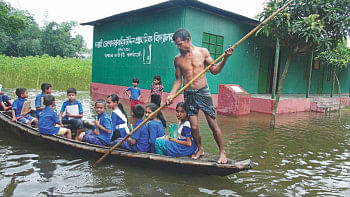Provide urgent support to flood affected people

The flood situation in the north and northeastern districts of the country continues to be of significant concern. Heavy rainfall in the first few days of July and onrush of water from upstream caused sudden flooding in the country's northeast and, eventually, in northern districts. As of writing this editorial, several northern and northeastern districts continue to be inundated with rivers continuing to swell. According to the Flood Forecasting and Warning Centre (FFWC), the water level of Jamuna and Padma rivers will continue to rise till Friday.
The water of the Teesta crossed the danger level early Wednesday, inundating villages in low-lying areas of Lalmonirhat. This has also resulted in the swelling of the Dharla. The combined effects of this, along with rising water levels of other rivers, mean that the situation in certain regions of Kurigram and Bogura needs to be followed closely.
For now the good news is that except for the Khowai, the Someswari and the Dhalai rivers, water levels of major rivers in the northeastern region of the country are falling, and the trend may continue for 48 hours. This might provide the inhabitants of the region with some respite from flooding soon.
However, the fact remains that much of the damage from flooding has already been done. In places like Sunamganj, several thousand people have been badly affected by the flooding. In Netrakona, vast areas of Kalmakanda upazila have been inundated. And several other regions have experienced similar situations. Farmers of some north and northeastern districts have incurred substantial crop losses. So, the government needs to urgently provide support to the farmers, as well as the general people of these regions.
The outbreak of waterborne diseases is always a risk after floods. Therefore, besides providing people with financial and rehabilitative assistance, the government, working with NGOs and others, needs to ensure that everyone across the affected regions have immediate access to adequate medicines and medical support.
As we navigate the age of climate change, it is important to take note of the fact that extreme flooding events have become the norm. Instead of rushing to provide support and relief after disaster strikes, Bangladesh must prioritise adaptation with a focus on climate resilient infrastructure both in practice and at a policy level.


 For all latest news, follow The Daily Star's Google News channel.
For all latest news, follow The Daily Star's Google News channel. 





Comments